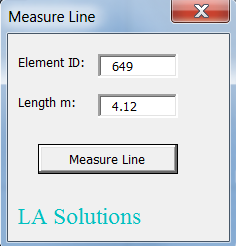Introduction
This article is written for an audience of Visual Basic for Applications (VBA) programmers. Specifically, VBA programmers wanting to write code for Bentley Systems MicroStation® VBA.
Questions similar to this appear on the Bentley Discussion Groups.
Q How can I measure a LineElement?
A
We can write a locator class that lets a user select a LineElement,
then measure the length of the selected element.
This article shows how to start a Locator class from a UserForm,
locate a LineElement,
then display the line's length on the UserForm.
Q Communication with a class …
- How can I pass information between two VBA classes?
- How can I pass information to and from a class that
Implements ILocateCommandEvents?
A A class object can include private variables that you can assign using a class Property.
For example, if you have a UserForm that starts a locator class, then you can set a property in your
locator that informs it about its originator.
The locator class can then call methods of the originator.
This article shows how to create a Locator class from a UserForm,
then set a reference to the UserForm in the locator class.
The locator class can subsequently user that reference to call methods or properties of the UserForm.
VBA Solution

A line is represented by a LineElement object.
One of its properties is Length (in the model's master units).
We need to locate a LineElement in a model and
display its length on a form.
From the user's perspective, the sequence of operation is …
- Run the MeasureLine project
- the modeless
UserFormshows
- the modeless
- Click the Measure Line button
- the locator class starts and prompts the user to identify a
LineElement
- the locator class starts and prompts the user to identify a
- User identifies a valid element
- the locator class updates the Length textbox on the
UserForm
- the locator class updates the Length textbox on the
As a VBA programmer, you'll see that the UserForm creates the locator class
and sets a reference to itself.
The locator class then has a mechanism to call methods & properties of its originator.
Next, the code invokes CommandState.StartLocate that starts the locate events.
When the user has identified a valid element, the locator class
sets the UserForm's Length property.
Locator Class
The locator is a VBA class module that
Implements ILocateCommandEvents.
We customise the event handlers to accept only LineElements.
We include a reference to the UserForm that called the class,
then use that form's methods to show the length of the located element.
The key to inter-class communication is the member variable that holds a reference to the originating class …
' ---------------------------------------------------------------------
' Member variable stores a reference to the UserForm that called this
' locate class
' ---------------------------------------------------------------------
Private m_oOriginator As frmLocator
' ---------------------------------------------------------------------
' Property lets us assign our form to this variable
' e.g. Set oLocator.Originator = Me
' ---------------------------------------------------------------------
Public Property Set Originator(ByRef oForm As frmLocator)
Set m_oOriginator = oForm
End PropertyUserForm
The UserForm is a VBA form module.
The Measure Line button has a _Click event that creates the locator class,
sets the property that references itself,
then starts the locate operation …
Private Sub cmdMeasure_Click()
' Start a new locate command by invoking our class clsLocator
Dim oLocator As New clsLocator
Set oLocator.Originator = Me
CommandState.StartLocate oLocator
End SubVBA Project
The VBA project has three modules …
- Normal module
modMainthat contains the project entry point subroutineMain - Class module
clsLocatorthatImplements ILocateCommandEvents - Form module
frmLocatorthat provides a user interface
Start the tool using the MicroStation keyin: vba run [MeasureLine]modMain.Main

Download the Line Filter
You can download the Measure Line MVBA project.
The project includes the MVBA project MeasureLine.mvba.
- Unpack the ZIP archive to a suitable location, such as
C:\Program Files\Bentley\Workspace\Standards\vba - Start the tool with the MicroStation keyin:
vba run [MeasureLine]modMain.Main
